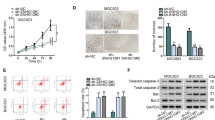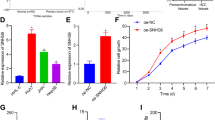Abstract
Background
Chemotherapy is, next to surgery and radiotherapy, the mainstay regimen for the clinical management of gastric cancer. This therapy is, however, heavily compromised by the acquisition of resistance. Here, we aimed to clarify the potential involvement of long non-coding RNA SNGH3 in the acquisition of cisplatin resistance and stemness in gastric cancer.
Methods
Cell viability and proliferation were measured using Cell Counting Kit-8 and colony formation assays, respectively. Stem cell-like cell growth was evaluated using a mammosphere formation assay. RNA levels of SNHG2, OCT-4, SOX-2, CD44, miR-3619-5p and ARL2 were determined using qRT-PCR, whereas protein levels of OCT-4, SOX-2, CD44, ARL2, STAT3 and pSTAT3 were determined using Western blotting. Dual luciferase reporter assays were employed to interrogate regulatory interactions between STAT3, SNHG3, miR-3619-5p and ARL2, respectively. Direct binding of STAT3 to the SNHG3 promoter was investigated using a chromatin immunoprecipitation assay.
Results
We found that IL-6 triggered stem cell-like properties in cisplatin-treated gastric cancer cells and activated STAT3, which in turn transcriptionally regulated SNHG3 expression. SNHG3 expression up-regulation positively correlated with cisplatin resistance and stemness of gastric cancer cells, while SNHG3 down-regulation inhibited stem cell-like properties. In addition, we found that SNHG3 up-regulated ARL2 expression through sponging miR-3619-5p, which predominantly mediated the oncogenic properties of SNHG3 in this disease.
Conclusions
Our data indicate an involvement of aberrant SNHG3 over-expression in the acquisition of both cisplatin resistance and stemness of gastric cancer cells, and of the IL-6/STAT3/SNHG3/miR-3619-5p/ARL2 signaling cascade in the oncogenic properties of SNHG3.








Similar content being viewed by others
Data Availability
Not applicable.
Change history
01 February 2022
This article has been retracted. Please see the Retraction Notice for more detail: https://doi.org/10.1007/s13402-022-00662-z
Abbreviations
- lncRNA:
-
Long non-coding RNA
- ChIP:
-
Chromatinimmunoprecipitation
- ATCC:
-
American Type CultureCollection
- CCK-8:
-
Cell Counting Kit-8
References
E. Van Cutsem, X. Sagaert, B. Topal, K. Haustermans, H. Prenen, Gastric cancer. Lancet 388, 2654–2664 (2016)
F. Bray, J. Ferlay, I. Soerjomataram, R.L. Siegel, L.A. Torre, A. Jemal, Global cancer statistics 2018: GLOBOCAN estimates of incidence and mortality worldwide for 36 cancers in 185 countries. CA Cancer J. Clin. 68, 394–424 (2018)
Y.Y. Lee, M.H. Derakhshan, Environmental and lifestyle risk factors of gastric cancer. Arch. Iran. Med. 16, 358–365 (2013)
A. Digklia, A.D. Wagner, Advanced gastric cancer: Current treatment landscape and future perspectives. World J. Gastroenterol. 22, 2403–2414 (2016)
L. de Mestier, S. Lardiere-Deguelte, J. Volet, R. Kianmanesh, O. Bouche, Recent insights in the therapeutic management of patients with gastric cancer. Dig. Liver Dis. 48, 984–994 (2016)
H. Yoon, N. Kim, Diagnosis and management of high risk group for gastric cancer. Gut Liver 9, 5–17 (2015)
A. Schulenburg, K. Blatt, S. Cerny-Reiterer, I. Sadovnik, H. Herrmann, B. Marian, T.W. Grunt, C.C. Zielinski, P. Valent, Cancer stem cells in basic science and in translational oncology: can we translate into clinical application? J. Hematol. Oncol. 8, 16 (2015)
M.F. Clarke, J.E. Dick, P.B. Dirks, C.J. Eaves, C.H. Jamieson, D.L. Jones, J. Visvader, I.L. Weissman, G.M. Wahlet, Cancer stem cells–perspectives on current status and future directions: AACR Workshop on cancer stem cells. Cancer Res. 66, 9339–9344 (2006)
M. Najafi, K. Mortezaee, J. Majidpoor, Cancer stem cell (CSC) resistance drivers. Life Sci. 234, 116781 (2019)
J.J. Quinn, H.Y. Chang, Unique features of long non-coding RNA biogenesis and function. Nat. Rev. Genet. 17, 47–62 (2016)
L. Liu, J. Ni, X. He, Upregulation of the long noncoding RNA SNHG3 promotes lung adenocarcinoma proliferation. Dis. Markers 2018, 5736716 (2018)
P.F. Zhang, F. Wang, J. Wu, Y. Wu, W. Huang, D. Liu, X.-Y. Huang, X.-M. Zhang, Ai.Wu. Ke, LncRNA SNHG3 induces EMT and sorafenib resistance by modulating the miR-128/CD151 pathway in hepatocellular carcinoma. J. Cell. Physiol. 234, 2788–2794 (2019)
L. Hong, W. Chen, D. Wu, Y. Wang, Upregulation of SNHG3 expression associated with poor prognosis and enhances malignant progression of ovarian cancer. Cancer Biomark. 22, 367–374 (2018)
N. Li, X. Zhan, X. Zhan, The lncRNA SNHG3 regulates energy metabolism of ovarian cancer by an analysis of mitochondrial proteomes. Gynecol. Oncol. 150, 343–354 (2018)
W. Huang, Y. Tian, S. Dong, Y. Cha, J. Li, X. Guo, X. Yuan, The long non-coding RNA SNHG3 functions as a competing endogenous RNA to promote malignant development of colorectal cancer. Oncol. Rep. 38, 1402–1410 (2017)
Y. Xuan, Y. Wang, Long non-coding RNA SNHG3 promotes progression of gastric cancer by regulating neighboring MED18 gene methylation. Cell Death Dis. 10, 694 (2019)
J. Long, C. Jiang, B. Liu, Q. Dai, R. Hua, C. Chen, B. Zhang, H. Li, Maintenance of stemness by miR-589-5p in hepatocellular carcinoma cells promotes chemoresistance via STAT3 signaling. Cancer Lett. 423, 113–126 (2018)
Z. Zhang, Q. Duan, H. Zhao, T. Liu, H. Wu, Q. Shen, C. Wang, T. Yin, Gemcitabine treatment promotes pancreatic cancer stemness through the Nox/ROS/NF-kappaB/STAT3 signaling cascade. Cancer Lett. 382, 53–63 (2016)
Y. Ning, Y. Cui, X. Li, X. Cao, A. Chen, C. Xu, J. Cao, X. Luo, Co-culture of ovarian cancer stem-like cells with macrophages induced SKOV3 cells stemness via IL-8/STAT3 signaling. Biomed. Pharmacother. 103, 262–271 (2018)
T. Wang, J.F. Fahrmann, H. Lee, Y.J. Li, S.C. Tripathi, C. Yue, G. Somlo, R. Jandial, D. Ann, S. Hanash, R. Jove, H. Yu, JAK/STAT3-regulated fatty acid beta-oxidation is critical for breast cancer stem cell self-renewal and chemoresistance. Cell Metab. 27, 1357 (2018)
W. He, J. Wu, J. Shi, Y.M. Huo, W. Dai, J. Geng, L. Ping, Y. Min-Wei, F. Yuan, W. Wei, Z.-G. Zhang, A. Habtezion, Y.-W. Sun, J. Xue, IL22RA1/STAT3 signaling promotes stemness and tumorigenicity in pancreatic cancer. Cancer Res. 78, 3293–3305 (2018)
C. Zhang, S. Mukherjee, C. Tucker-Burden, J.L. Ross, M.J. Chau, J. Kong, D.J. Brat, TRIM8 regulates stemness in glioblastoma through PIAS3-STAT3. Mol. Oncol. 11, 280–294 (2017)
Y. An, B. Wang, X. Wang, G. Dong, J. Jia, Q. Yang, SIRT1 inhibits chemoresistance and cancer stemness of gastric cancer by initiating an AMPK/FOXO3 positive feedback loop. Cell Death Dis. 11, 115 (2020)
Y. Liu, H. Chen, P.M. Zheng, Y.X. Zheng, Q. Luo, G.H. Xie, Y. Ma, L. Shen, ICG-001 suppresses growth of gastric cancer cells and reduces chemoresistance of cancer stem cell-like population. J. Exp. Clin. Canc. Res. 36, (2017)
X.D. Peng, Q.J. Kang, R. Wan, Z.W. Wang, miR-26a/HOXC9 dysregulation promotes metastasis and stem cell-like phenotype of gastric cancer. Cell. Physiol. Biochem. 49, 1659–1676 (2018)
E. Charafe-Jauffret, C. Ginestier, F. Iovino, C. Tarpin, M. Diebel, B. Esterni, G. Houvenaeghel, J.-M. Extra, F. Bertucci, J. Jacquemier, L. Xerri, G. Dontu, G. Stassi, Y. Xiao, S.H. Barsky, D. Birnbaum, P. Viens, M.S. Wicha, Aldehyde dehydrogenase 1-positive cancer stem cells mediate metastasis and poor clinical outcome in inflammatory breast cancer. Clin. Cancer Res. 16, 45–55 (2010)
G.H. Xu, J. Shen, X.H.O. Yang, M. Sasahara, X.L. Su, Cancer stem cells: the ‘heartbeat’ of gastric cancer. J. Gastroenterol. 48, 781–797 (2013)
L. Salmena, L. Poliseno, Y. Tay, L. Kats, P.P. Pandolfi, A ceRNA hypothesis: the Rosetta Stone of a hidden RNA. language? Cell 146, 353–358 (2011)
S. Zheng, F. Jiang, D. Ge, J. Tang, H. Chen, J. Yang, Y. Yao, J. Yan, J. Qiu, Z. Yin, Y. Ni, L. Zhao, X. Chen, H. Li, L. Yang, LncRNA SNHG3/miRNA-151a-3p/RAB22A axis regulates invasion and migration of osteosarcoma. Biomed. Pharmacother. 112, 108695 (2019)
J. Chen, Z. Wu, Y. Zhang, LncRNA SNHG3 promotes cell growth by sponging miR-196a-5p and indicates the poor survival in osteosarcoma. Int. J. Immunopathol. Pharmacol. 33, 2058738418820743 (2019)
L. Wang, K. Su, H. Wu, J. Li, D. Song, LncRNA SNHG3 regulates laryngeal carcinoma proliferation and migration by modulating the miR-384/WEE1 axis. Life Sci. 232, 116597 (2019)
Q. Zhao, C. Wu, J. Wang, X. Li, Y. Fan, S. Gao, K. Wang, LncRNA SNHG3 promotes hepatocellular tumorigenesis by targeting miR-326. Tohoku. J. Exp. Med. 249, 43–56 (2019)
X. Niu, S. Liu, L. Jia, J. Chen, Role of MiR-3619-5p in beta-catenin-mediated non-small cell lung cancer growth and invasion. Cell. Physiol. Biochem. 37, 1527–1536 (2015)
Q. Zhang, S. Miao, X. Han, C. Li, M. Zhang, K. Cui, T. Xiong, Z. Chen, C. Wang, H. Xu, MicroRNA-3619-5p suppresses bladder carcinoma progression by directly targeting beta-catenin and CDK2 and activating p21. Cell Death Dis. 9, 960 (2018)
A. Tan, Q. Li, L. Chen, CircZFR promotes hepatocellular carcinoma progression through regulating miR-3619-5p/CTNNB1 axis and activating Wnt/beta-catenin pathway. Arch. Biochem. Biophys. 661, 196–202 (2019)
K. Fite, J. Gomez-Cambronero, Down-regulation of microRNAs (MiRs) 203, 887, 3619 and 182 prevents vimentin-triggered, phospholipase D (PLD)-mediated cancer cell invasion. J. Biol. Chem. 291, 719–730 (2016)
S. Li, C. Wang, X. Yu, H. Wu, J. Hu, S. Wang, Z. Ye, miR-3619-5p inhibits prostate cancer cell growth by activating CDKN1A expression. Oncol. Rep. 37, 241–248 (2017)
M. Zhang, H. Luo, L. Hui, MiR-3619-5p hampers proliferation and cisplatin resistance in cutaneous squamous-cell carcinoma via KPNA4. Biochem. Biophys. Res. Commun. 513, 419–425 (2019)
R. Peng, J. Men, R. Ma, Q. Wang, Y. Wang, Y. Sun, J. Ren, miR-214 down-regulates ARL2 and suppresses growth and invasion of cervical cancer cells. Biochem. Biophys. Res. Commun. 484, 623–630 (2017)
K. Taniuchi, S. Iwasaki, T. Saibara, BART inhibits pancreatic cancer cell invasion by inhibiting ARL2-mediated RhoA inactivation. Int. J. Oncol. 39, 1243–1252 (2011)
Y. Wang, G. Guan, W. Cheng, Y. Jiang, F. Shan, A. Wu, P. Cheng, Z. Guo, ARL2 overexpression inhibits glioma proliferation and tumorigenicity via down-regulating AXL. BMC Cancer. 18, 599 (2018)
A. Beghin, S. Belin, R. Hage-Sleiman, S. Brunet Manquat, S. Goddard, E. Tabone, L.P. Jordheim, I. Treilleux, M.-F. Poupon, J.-J. Diaz, C. Dumontet, ADP ribosylation factor like 2 (Arl2) regulates breast tumor aggressivity in immunodeficient mice. PLoS One 4, e7478 (2009)
Funding
This work was supported by Shanghai Anticancer Association “aoxiang” Project (SACA-AX201901).
Author information
Authors and Affiliations
Contributions
Bo Sun, Yang Han, Hong Cai, Hua Huang and Yi Xuan collected and assembled the data. Bo Sun and Yang Han performed the statistical analyses. Hong Cai and Yi Xuan conceived and designed the study and wrote the manuscript. All authors read and approved the final manuscript.
Corresponding authors
Ethics declarations
Conflict of interest
No conflicts of interest, financial or otherwise, are declared by the authors.
Consent for publication
All of the authors have approved publication of this work.
Ethics approval and consent to participate
The study was approved by the Institutional Ethics Committee of Fudan University Shanghai Cancer Center and performed in strict accordance to NIH guidelines.
Additional information
Publisher's Note
Springer Nature remains neutral with regard to jurisdictional claims in published maps and institutional affiliations.
This article has been retracted. Please see the retraction notice for more detail: https://doi.org/10.1007/s13402-022-00662-z
About this article
Cite this article
Sun, B., Han, Y., Cai, H. et al. RETRACTED ARTICLE: Long non-coding RNA SNHG3, induced by IL-6/STAT3 transactivation, promotes stem cell-like properties of gastric cancer cells by regulating the miR-3619-5p/ARL2 axis. Cell Oncol. 44, 179–192 (2021). https://doi.org/10.1007/s13402-020-00560-2
Received:
Revised:
Accepted:
Published:
Issue Date:
DOI: https://doi.org/10.1007/s13402-020-00560-2




